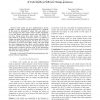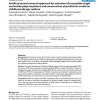392 search results - page 73 / 79 » Reversal Complexity Revisited |
WCRE
2009
IEEE
14 years 3 months ago
2009
IEEE
—Code smells are poor implementation choices, thought to make object-oriented systems hard to maintain. In this study, we investigate if classes with code smells are more change-...
RE
2001
Springer
14 years 1 months ago
2001
Springer
at different levels of abstraction. There are two very different ways of using such languages. One approach is based on the manifestation of a single model, with construction of di...
BMCBI
2008
13 years 8 months ago
2008
Background: Probability based statistical learning methods such as mutual information and Bayesian networks have emerged as a major category of tools for reverse engineering mecha...
BMCBI
2004
13 years 8 months ago
2004
Background: Screening of various gene markers such as single nucleotide polymorphism (SNP) and correlation between these markers and development of multifactorial disease have pre...
DAM
2011
13 years 3 months ago
2011
Partial words, which are sequences that may have some undefined positions called holes, can be viewed as sequences over an extended alphabet A = A ∪ { }, where stands for a hol...


